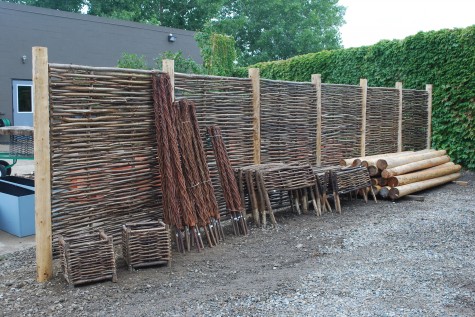You would laugh if you could see all of the boxes of 35mm pictures that are littering my drawing studio right now. No matter whatever possessed me to get them down off the shelf, and go through them, I am in that sore tooth phase-I cannot leave them alone. Thus the posts about my first garden. Apparently more is to come from those pictures; some projects I still like. I have a little time to write about them-this March is shaping up to be a winter month, not a transition from winter to spring month. This picture of a brush fence I built many years ago strikes a current chord. I have had a container of English terra cotta and antiques stuck in England for 6 weeks-over a round of chestnut fencing that US customs does not like. Chestnut fencing is very common in England-chestnut slats and wire make for a rough and cottage ready, simple fencing that comes in rolls. There are panels, and gates, to go with. Chestnut fencing may be a fixture in England, but customs is not happy that I wish to import it to the US. Why is this? Standard fumigation techniques have been outlawed, with no substitute put in place. Suffice it to say that this has been very difficult. They are worried the fencing has bugs and I want to make available gardening materials from England. We finally got the fencing heat treated; the container should be in my hands by April 4. 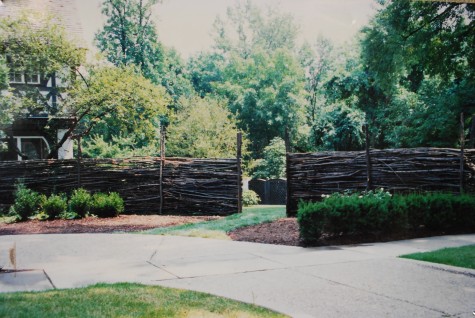
This client lived on a corner. Corner properties have no back yard. This means no clearly defined front and public space, and back, or private space. This 1920’s tudor style house made its own architectural demands. My idea-a rough brush fence would define the front landscape, separate from the side and rear. I still love this fence, though it is long gone. Thick maple branch posts set at intervals capture good size and very long branches-laid in between; all of the branches were courtesy of Westside Forestry. The big idea here-a fence can be built from what is due to be discarded. The bottom branches were laid in between parallel sets of maple poles. The poles were then wired together with concrete wire to keep them parallel, and the next layer of brush would be laid. Very low tech.
 Once the fence was in place, of course I planted sweet autumn clematis. What better plant to grow over, and soften this structure. The front gardens got laid out and planted. Yews trimmed in oval shapes were set square in generous swoops of Japanese painted ferns marked the arbor entrance to the side garden.
Once the fence was in place, of course I planted sweet autumn clematis. What better plant to grow over, and soften this structure. The front gardens got laid out and planted. Yews trimmed in oval shapes were set square in generous swoops of Japanese painted ferns marked the arbor entrance to the side garden.
 Large flowered clematis hybrids were planted at the base of the brush fence, which eventually was frosted with a single plant of sweet autumn clematis. Trained to grow sideways on the top of the fence, it added considerable height to the fence.
Large flowered clematis hybrids were planted at the base of the brush fence, which eventually was frosted with a single plant of sweet autumn clematis. Trained to grow sideways on the top of the fence, it added considerable height to the fence. 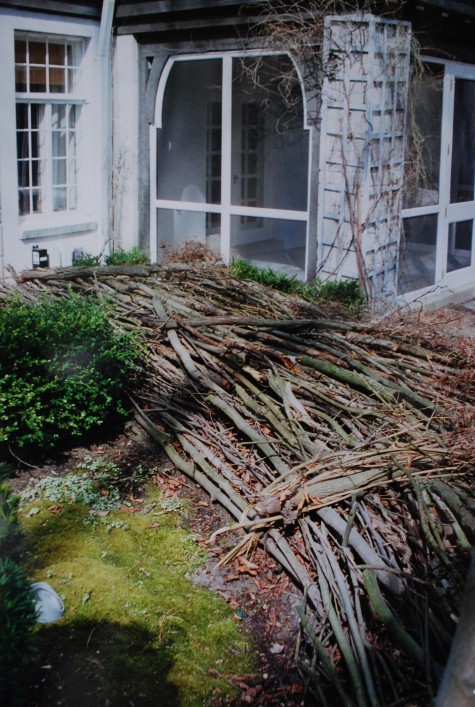 One late winter night, a straight line wind took the fence down. Looking at this picture today, I remember my shock. The maple posts snapped. They were not one bit rotted-that same wind took half of the roof off my building and deposited it in the street.
One late winter night, a straight line wind took the fence down. Looking at this picture today, I remember my shock. The maple posts snapped. They were not one bit rotted-that same wind took half of the roof off my building and deposited it in the street.
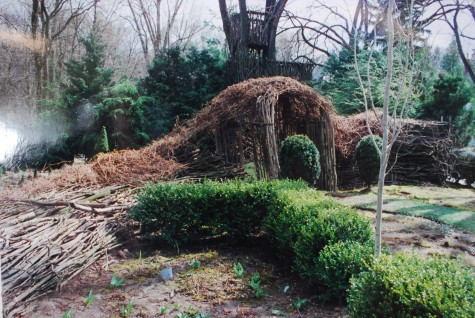
Always in a garden-there is trouble. Plants that do not survive the winter. Plants that do not survive terrible storms. Too much water; not enough water. Plants that do not survive with no reasonable explanation. Trouble-every garden sees plenty of this. This trouble-terrible. The timing could not have been better though-it was very early spring. Nothing else in the garden was damaged.
 The broken brush fence exposed what I had thought to keep private for my clients. This turn of events-not much to my liking. As it turned out, it was a fairly simple matter to repair.
The broken brush fence exposed what I had thought to keep private for my clients. This turn of events-not much to my liking. As it turned out, it was a fairly simple matter to repair.
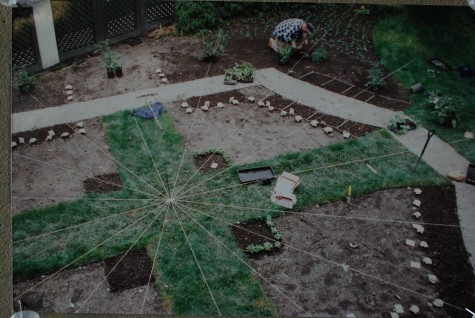 In the side yard, off the sun porch, a formal herb garden had been under construction. We were able to go ahead and plant, once spring came.
In the side yard, off the sun porch, a formal herb garden had been under construction. We were able to go ahead and plant, once spring came.
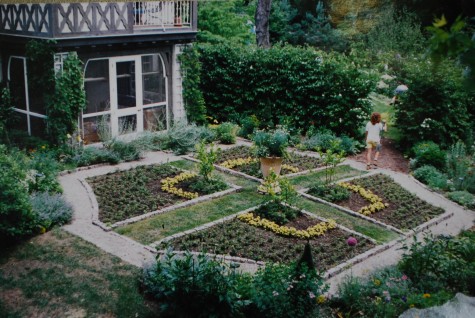 A very small formal garden sited off a side porch-this is how it looked, only seconds after it was first planted. The brush fence that made this space private-we put that fence back up, better than ever. This sheltered garden was devoted primarily to herbs. The tall hedge you see on the right of this picture-Cornus Kousa. It was planted in a curve opposite to the curve of brush fence. These features made the side garden very private.
A very small formal garden sited off a side porch-this is how it looked, only seconds after it was first planted. The brush fence that made this space private-we put that fence back up, better than ever. This sheltered garden was devoted primarily to herbs. The tall hedge you see on the right of this picture-Cornus Kousa. It was planted in a curve opposite to the curve of brush fence. These features made the side garden very private.
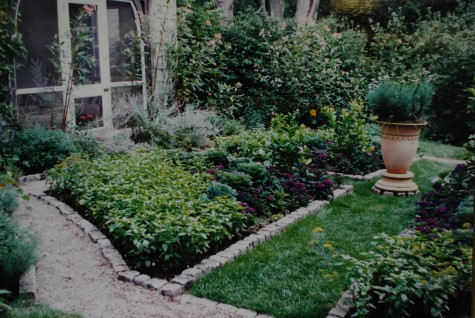
The herbs, notably basil, had good company. Heliotrope. Perovskia. Marguerite daisies. Granite cobbles, and decomposed granite. The entrance from the street-a recently rebuilt brush fence. This garden exists only in these pictures now-the client went on to reconfigure the entire landscape. Every garden I work in is different than it was 20 years ago-nothing in a garden stands still.

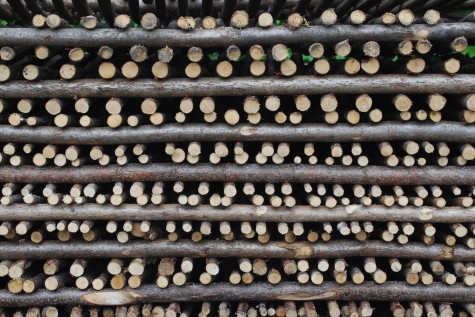 I wrote a few days ago regarding my excitement about the delivery of a container load of hazel wood hurdles from Belgium; the order we placed in May finally arrived. Wattles and hurdles are panels, woven from the coppice wood of willow and hazel wood. I personally favor the heft and longevity of the hazel wood; it is vastly more durable and substantial than willow. Coppicing is the practice of cutting trees or shrubs to the quick, with the intent of harvesting the branches for fuel, or fencing. The shrub or tree regrows, only to have its branches harvested again. Woven hurdles keep the livestock out of the vegetable garden. They border herb and vegetable gardens. They provide privacy without being utterly opaque. They work wherever they are needed. Woven hurdles are a fence material friendly to a garden or landscape of any point of view.
I wrote a few days ago regarding my excitement about the delivery of a container load of hazel wood hurdles from Belgium; the order we placed in May finally arrived. Wattles and hurdles are panels, woven from the coppice wood of willow and hazel wood. I personally favor the heft and longevity of the hazel wood; it is vastly more durable and substantial than willow. Coppicing is the practice of cutting trees or shrubs to the quick, with the intent of harvesting the branches for fuel, or fencing. The shrub or tree regrows, only to have its branches harvested again. Woven hurdles keep the livestock out of the vegetable garden. They border herb and vegetable gardens. They provide privacy without being utterly opaque. They work wherever they are needed. Woven hurdles are a fence material friendly to a garden or landscape of any point of view. I have a client who has become a friend; he supports Michigan industry in a big way and was so pleased these stripped cedar fence poles we bought are Michigan grown. Though I ordered 5″ diameter poles, 10 feet long, they looked like telephone poles when they got delivered from a supplier in Michigan’s Upper Peninsula. As I relentlessly speak to issues of proportion, I was worried I had gone over the edge by an inch. I was wringing my hands, until the fence went up. I should not have worried. The size of the pole was perfect for the heft and texture of the fence. The bare cedar poles are a good contrast to the woven hazel wood, which has all of its bark intact.
I have a client who has become a friend; he supports Michigan industry in a big way and was so pleased these stripped cedar fence poles we bought are Michigan grown. Though I ordered 5″ diameter poles, 10 feet long, they looked like telephone poles when they got delivered from a supplier in Michigan’s Upper Peninsula. As I relentlessly speak to issues of proportion, I was worried I had gone over the edge by an inch. I was wringing my hands, until the fence went up. I should not have worried. The size of the pole was perfect for the heft and texture of the fence. The bare cedar poles are a good contrast to the woven hazel wood, which has all of its bark intact.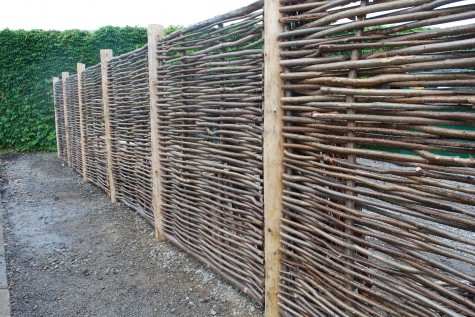 There is no substitute for the time when the talk ends, and the making begins. We set a pole down 24″ or so below grade, and set a panel up next to it. These panels are made by hand, and vary in width somewhat. One pole, one panel, and so on. This one step at a time construction ensures that the space between two poles is fitted to a specific panel. Steve toe-nail screwed the panels to the center of each post; this is a sturdy construction. What I like even better? This fence has no back or front; the panels are the same back and front. How friendly is this to neighboring properties? This fence looks good to both sides.
There is no substitute for the time when the talk ends, and the making begins. We set a pole down 24″ or so below grade, and set a panel up next to it. These panels are made by hand, and vary in width somewhat. One pole, one panel, and so on. This one step at a time construction ensures that the space between two poles is fitted to a specific panel. Steve toe-nail screwed the panels to the center of each post; this is a sturdy construction. What I like even better? This fence has no back or front; the panels are the same back and front. How friendly is this to neighboring properties? This fence looks good to both sides.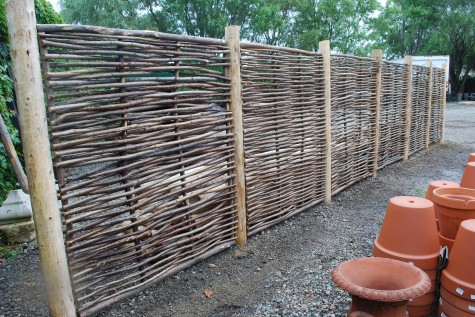 I have a client who plans to screen his hot tub with this fencing. It was the subject of intense debate today-will these hurdles screen a man who is happily skinny dipping? I vote yes-unless the neighbor plans to be close enough to see through the hurdle branches. The neighbor with his nose pressed to the fence-that is the subject of another essay, is it not? The fence is also friendly to vines that need to grip to climb. Clematis grown on this fence is especially lovely. We are careful to install the fence slightly above the existing grade of the ground. Wood in constant contact with soil will deteriorate much more quickly than wood that is able to shed water.
I have a client who plans to screen his hot tub with this fencing. It was the subject of intense debate today-will these hurdles screen a man who is happily skinny dipping? I vote yes-unless the neighbor plans to be close enough to see through the hurdle branches. The neighbor with his nose pressed to the fence-that is the subject of another essay, is it not? The fence is also friendly to vines that need to grip to climb. Clematis grown on this fence is especially lovely. We are careful to install the fence slightly above the existing grade of the ground. Wood in constant contact with soil will deteriorate much more quickly than wood that is able to shed water.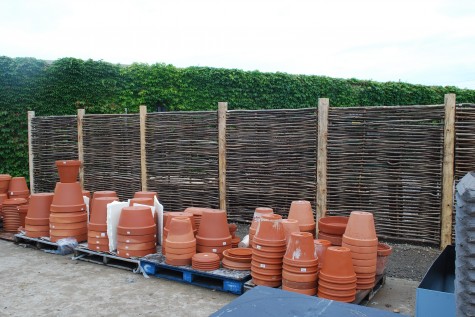 The fence is good looking with contemporary steel ornament, traditional terra cotta pots, a funky birdbath made from recycled materials, or a formal lead cistern fountain. This is by way of saying this fence looks good with almost anything. As to its longevity, imagine how long it takes a dead tree to fall and deteriorate. Branches and twigs are not good materials for the compost pile, as they break down so slowly. We have stocked this fencing for 8 years now. I have yet to have someone tell me it had disintegrated. Wood fences do age though-that is part of their charm.
The fence is good looking with contemporary steel ornament, traditional terra cotta pots, a funky birdbath made from recycled materials, or a formal lead cistern fountain. This is by way of saying this fence looks good with almost anything. As to its longevity, imagine how long it takes a dead tree to fall and deteriorate. Branches and twigs are not good materials for the compost pile, as they break down so slowly. We have stocked this fencing for 8 years now. I have yet to have someone tell me it had disintegrated. Wood fences do age though-that is part of their charm.